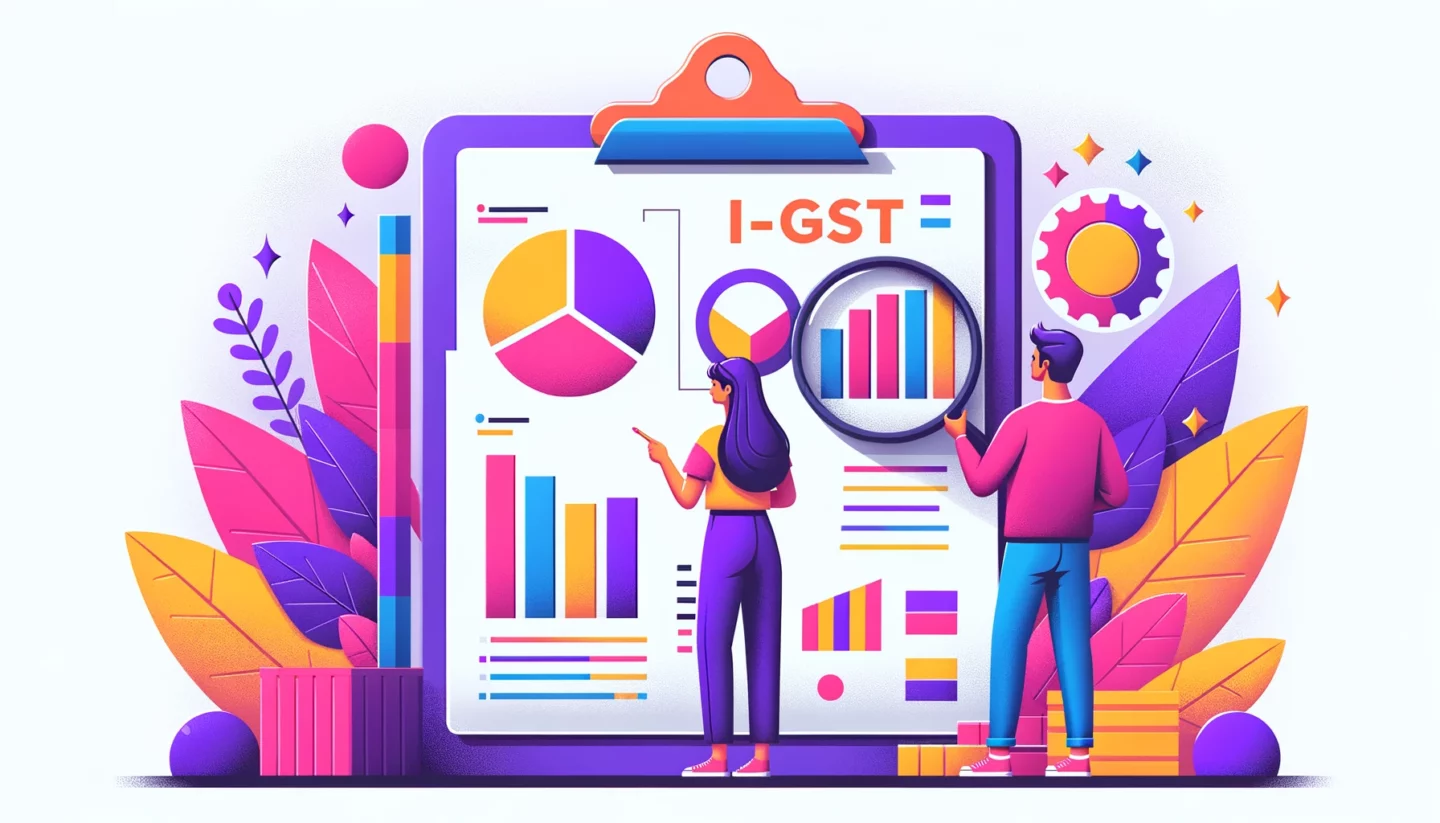Exploring the advantages and disadvantages of IGST
- 20 Sep 24
- 16 mins

Exploring the advantages and disadvantages of IGST
Key Takeaways
- IGST simplifies the tax structure for interstate transactions by replacing multiple taxes with a single, unified tax, reducing compliance burdens for businesses.
- The destination-based nature of IGST ensures fair revenue distribution among states, aligning tax revenue with the state where goods or services are consumed.
- IGST facilitates a seamless flow of input tax credit across states, eliminating the cascading effect of taxes and reducing the overall tax burden on consumers.
- While IGST promotes interstate commerce and economic efficiency, small businesses may face challenges in adapting to its compliance and technological requirements.
- Regular updates and consultations with tax professionals are essential for businesses to navigate the complexities of IGST and optimize their tax positions effectively.
The implementation of the Goods and Services Tax (GST) in India was a landmark reform aimed at transforming the country's complex tax structure into a more simplified, unified system. Among the various components that constitute the GST, the Integrated Goods & Services Tax (IGST) stands out as a pivotal element designed to address the challenges of interstate trade, commerce and taxation, effectively mitigating issues related to indirect taxes and the erstwhile prevalence of double taxation.
IGST not only aims to streamline the process of tax collection on goods and services across state borders but also seeks to ensure that the tax revenue accrues to the state where the goods or services are ultimately consumed. This approach marks a significant shift from the previous indirect taxation regime, promising to enhance the efficiency of tax administration and reduce the tax burden on businesses and consumers alike.
However, like any major policy reform, the introduction of IGST has been met with both enthusiasm and skepticism. On one hand, it is lauded for its potential to create a seamless national market, eliminate the cascading effect of taxes, and simplify the tax structure. On the other hand, concerns have been raised regarding its implementation challenges, impact on small and medium enterprises, and the complexities involved in interstate trade transactions.
What is Integrated Goods and Services Tax (IGST)?
The Integrated Goods & Services Tax (IGST) is a key component of the Goods and Services Tax (GST) framework in India, designed to address the taxation of interstate trade transactions of goods and services. Enacted under the IGST Act of 2017, it is a unified tax levied on the supply of goods and services from one state to another, as well as on imports and exports. The primary aim of IGST is to consolidate the complex maze of state and central taxes into a single, coherent tax structure, facilitating a smoother flow of goods across state boundaries and making the Indian market more integrated and efficient.
Under the GST regime, taxes are levied at every point of sale, whether within a state (intrastate) or across states (interstate). For intrastate transactions, the tax is split into Central Goods and Services Tax (CGST) and State Goods and Services Tax (SGST), where both the central and state governments share the revenue. However, for interstate transactions, IGST is applied, ensuring that the tax is collected by the central government and then distributed to the destination state, the state where the goods or services are ultimately consumed. This mechanism aligns with the 'destination-based tax' principle, which is a cornerstone of the GST philosophy.
IGST is charged at the same GST rate as CGST and SGST combined, simplifying tax rates across the board and ensuring that the total tax burden on the consumer does not increase. It plays a crucial role in maintaining the integrity of the national market by eliminating the cascading effect of taxes, which was a significant drawback of the pre-GST tax regime. By allowing the seamless flow of tax credits from one state to another, IGST ensures that the final consumer bears only the GST charged by the last dealer in the supply chain, with all previous taxes being set off as input tax credits.

The implementation of IGST has been a significant step towards realizing the vision of a unified tax system in India, aiming to make doing business easier, reduce tax evasion, and ensure a fair distribution of tax revenues among states, including Union Territories. It represents a move towards a more transparent, technology-driven, and efficient tax administration, fostering a conducive environment for economic growth and competitiveness in the Indian market.
Features of Integrated Goods & Services Tax (IGST)
The Integrated Goods & Services Tax (IGST) model is a fundamental pillar of the GST framework in India, designed to streamline the tax structure for interstate transactions. Its features are crafted to address the complexities of the pre-GST tax regime, promoting a more integrated and efficient economic environment. Here are the key features of IGST:
- Unified Tax Structure: IGST consolidates various central and state taxes that were applicable on interstate transactions before GST, such as Central Sales Tax (CST), State VAT, Central Excise Duty, and Service Tax, into a single tax. This unification simplifies the tax framework, making it easier for business owners to comply and for the government to administer.
- Destination-Based Tax: One of the core principles of IGST is that it is a destination-based tax. This means that the tax revenue collected under IGST is credited to the state where the goods or services are consumed. This feature aligns with the GST's aim to tax consumption rather than production, ensuring a fair distribution of tax revenue among states, including Union Territories.
- Seamless Input Tax Credit: IGST facilitates a seamless flow of input tax credit from one state to another. This ensures that businesses can claim credit for the tax paid on inputs, regardless of where they were purchased, against the tax liability on their output. This mechanism effectively removes the cascading effect of taxes, reducing the overall tax burden on the end consumer.
- Simplifies Interstate Transactions: By applying a single IGST on all interstate transactions, the system simplifies the process of selling and buying goods and services across state boundaries. This eliminates the need for businesses to register and comply with tax regulations in multiple states, including Union Territories, thereby reducing compliance costs and complexities.
- Online Compliance and Administration: The entire process of IGST compliance, including registration, tax payment, and return filing, is conducted online through the GST portal. This digital approach enhances transparency, reduces paperwork, and makes it easier for both businesses and the tax authorities to manage tax obligations efficiently.
- Integrated with GST Network (GSTN): IGST operations are fully integrated with the GST Network (GSTN), a comprehensive IT backbone that facilitates a smooth and transparent tax administration system. This integration allows for real-time monitoring and reconciliation of tax credits across states, including Union Territories, enhancing compliance and reducing fraud.
- Regulation and Oversight: The IGST is regulated by the IGST Act, which provides the legal framework and guidelines for its implementation. The GST Council, comprising representatives from the central and all state governments, including Union Territories, oversees the policy decisions related to IGST, ensuring a collaborative approach to tax governance.
- Enhances Economic Efficiency: By reducing the tax on tax effect and simplifying the tax regime for interstate commerce, IGST promotes economic efficiency. It encourages a free flow of goods across state borders, including Union Territories, contributing to the creation of a unified national market, which is essential for economic growth and competitiveness.
The introduction of IGST, with its emphasis on simplifying the tax structure for interstate transactions and ensuring equitable distribution of tax revenue, including to Union Territories, marks a significant advancement in India's tax reform journey. By addressing the challenges of indirect taxes and double taxation, and by setting a uniform GST rate, IGST fosters a conducive environment for businesses, including service providers, to thrive.

It is crucial for businesses to stay informed about their tax obligations, including the implications of annual turnover and tax on turnover, to fully leverage the benefits of the IGST system and contribute to the nation's economic prosperity.
IGST Explained: An Example
To understand the Integrated Goods & Services Tax (IGST) in action, let's consider a practical example that illustrates how IGST facilitates interstate transactions and the flow of input tax credit across state lines.
Scenario:
Imagine a manufacturer based in Gujarat who produces furniture. This manufacturer sells a batch of furniture to a retailer located in Maharashtra. Since this transaction involves the movement of goods from one state (Gujarat) to another (Maharashtra), IGST is applicable.
Step-by-Step Breakdown:
- Sale of Furniture:
- The manufacturer in Gujarat sells furniture to the retailer in Maharashtra for INR 1,00,000.
- Assuming the applicable IGST rate is 18%, the manufacturer charges INR 18,000 as IGST on this transaction.
- The total amount paid by the retailer in Maharashtra to the manufacturer in Gujarat is INR 1,18,000 (INR 1,00,000 + INR 18,000 IGST).
- Payment of IGST:
- The manufacturer in Gujarat is responsible for depositing the collected IGST of INR 18,000 with the government.
- Input Tax Credit (ITC) Claimed by the Retailer:
- The retailer in Maharashtra, upon purchasing the furniture and paying IGST, is now eligible to claim an input tax credit of INR 18,000 for the IGST paid.
- This input tax credit can be used by the retailer to offset their output tax liability on subsequent sales within Maharashtra or in other states.
- Subsequent Sale in Maharashtra:
- Now, let's say the retailer sells the furniture within Maharashtra to a customer for INR 1,50,000.
- For intrastate sales within Maharashtra, both CGST and SGST are applicable. Assuming both are charged at 9% each, the total GST collected would be INR 27,000 (INR 13,500 as CGST and INR 13,500 as SGST).
- The retailer can use the IGST credit of INR 18,000 to offset the CGST and SGST liability. After utilizing the IGST credit, the retailer pays the remaining GST (INR 9,000) to the government.
Advantages and Disadvantages of IGST
The Integrated Goods and Services Tax (IGST) system, a cornerstone of India's GST framework for managing interstate transactions, brings with it a host of advantages designed to streamline business operations and tax administration. However, like any significant reform, it also presents certain challenges and disadvantages. Below, we explore both sides of the coin to provide a comprehensive understanding of IGST's impact.
Advantages of IGST
- Simplification of Tax Structure: IGST replaces multiple taxes and levies that were previously applicable on interstate transactions, such as Central Sales Tax (CST), State VAT, and others, with a single tax. This simplification aids in reducing compliance burdens for businesses and makes the tax system more transparent.
- Elimination of Cascading Tax Effect: By allowing full input tax credit (ITC) for IGST paid on the supply of goods and services across states, IGST eliminates the cascading effect of taxes (tax on tax), thereby reducing the overall cost of goods and services.
- Boost to Interstate Commerce: The seamless credit mechanism and simplified tax structure under IGST encourage businesses to engage in interstate commerce, contributing to the creation of a unified national market and enhancing the free flow of goods and services across state borders.
- Fair Revenue Distribution: IGST adheres to the destination principle, ensuring that the tax revenue is collected by the state where the goods or services are ultimately consumed. This leads to a fair distribution of tax revenue among states, aligning with the consumption patterns of the country.
- Enhanced Compliance and Efficiency: The centralized registration and online filing procedures under IGST, as part of the GST regime, streamline the process of tax compliance, reduce paperwork, and increase administrative efficiency.
Disadvantages of IGST
- Compliance Challenges for Small Businesses: Despite the simplification of the tax structure, small businesses and startups may still face challenges in understanding and complying with the IGST provisions, particularly those engaging in interstate transactions for the first time.
- Increased Operational Costs: For some businesses, the initial transition to the GST system, including the adoption of IGST, has led to increased operational costs. These include expenses related to upgrading IT systems, training staff on GST compliance, and hiring tax professionals.
- Complexity in Determining Place of Supply: In certain cases, especially in the services sector, determining the place of supply for the purpose of IGST can be complex. This complexity can lead to uncertainties and disputes regarding tax liabilities.
- Potential for Increased Prices: While IGST aims to reduce the overall tax burden, the initial implementation phase saw some businesses facing higher tax rates compared to the pre-GST era. This was partly due to the inability to claim input tax credit on certain expenses, leading to an increase in the cost of goods and services.
- Adaptation to Technology: The GST regime, including IGST, relies heavily on digital compliance and administration. Businesses that are not technologically adept may find it challenging to adapt to the online procedures for registration, tax payment, and filing returns.
Things to Keep in Mind About IGST

The Integrated Goods and Services Tax (IGST) is a significant component of India's GST framework, especially for businesses involved in interstate transactions. Understanding its nuances is crucial for compliance, optimizing tax credits, and ensuring smooth business operations. Here are key points businesses and individuals should keep in mind about IGST:
1. Understand the Place of Supply Rules
- The place of supply determines whether a transaction falls under IGST or the combination of CGST and SGST. For goods, it's usually the location of the goods at the time of delivery. For services, it can vary based on the type of service provided. Understanding these rules is crucial to apply the correct tax.
2. Correct Classification of Goods and Services
- Proper classification of goods and services under the correct HSN (Harmonized System of Nomenclature) for goods and SAC (Services Accounting Code) for services is essential. This ensures the correct rate of IGST is applied, avoiding penalties for underpayment or claims for refunds due to overpayment.
3. Seamless Input Tax Credit (ITC) Utilization
- IGST paid on input supplies can be utilized to offset IGST, CGST, or SGST liabilities, in that order of priority. Businesses should maintain accurate records of input taxes to maximize their ITC benefits and reduce out-of-pocket expenses.
4. Interstate vs. Intrastate Transactions
- Distinguishing between interstate and intrastate transactions is vital. IGST is levied on interstate transactions, while intrastate transactions attract CGST and SGST. Misclassification can lead to compliance issues and financial discrepancies.
5. Documentation and Compliance
- Proper documentation, including accurate invoicing and timely filing of returns, is key to IGST compliance. Invoices should clearly mention the IGST charged, and returns should be filed as per the prescribed timelines to avoid penalties.
6. Regular Updates and Changes
- The GST Council periodically reviews tax rates and regulations, including those for IGST. Businesses must stay updated on these changes to ensure compliance and optimize their tax positions.
7. Technology Adoption
- The GST regime, including IGST, relies heavily on digital processes for registration, tax payment, and return filing. Embracing technology and using GST-compliant software can simplify these processes and reduce errors.
8. Cross-Utilization of ITC
- IGST allows for the cross-utilization of credit, which is a significant advantage for businesses operating across state lines. Prioritize the utilization of IGST credit to offset IGST liabilities first, followed by CGST and SGST, to ensure optimal use of available credits.
9. Consultation with Tax Professionals
- Given the complexities of the IGST and its implications on business operations, consulting with tax professionals or GST practitioners can provide valuable insights, help in strategic planning, and ensure compliance.
10. Impact on Pricing and Contracts
- The implementation of IGST may affect the pricing of goods and services, especially in contracts spanning multiple states. Businesses should review and, if necessary, renegotiate contracts to factor in the implications of IGST.
Keeping these points in mind can help businesses navigate the complexities of IGST more effectively, ensuring compliance, optimizing tax credits, and maintaining smooth interstate operations. As the GST framework evolves, staying informed and adaptable is key to leveraging the benefits of IGST and contributing to a more streamlined and efficient tax system in India.
💡If you want to make your GST payments with your credit card, use Pice Business Payment app. Pice App allows you to make all business payments from vendors, GST, utilities, Rent and much more.
 By
By 


















